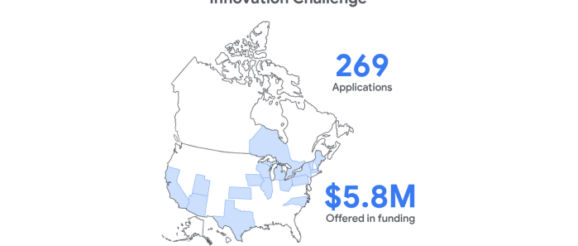Where US publishers see potential for innovation – Twipe

Recently Google announced the funding recipients of its first-ever “North American Innovation Challenge“. 34 projects were chosen across the US and Canada, with funding totaling $5.8 million. We’re no strangers to Google’s Innovation Challenge here in Europe (or as it was previously called the DNI fund). At Twipe we’ve been fortunate enough to have a few different projects funded through this program, including JAMES, Your Digital Butler and EngageReaders. Now after six rounds in Europe, Google has turned its focus (and money) to the US. Join us as we dig into what projects received funding and what areas in which publishers are seeing a potential for innovation and growth.
Growing focus on audio
Similar to Europe, we see more publishers in the US experimenting with audio. Lee Enterprises received funding to create a tool that will streamline the creation of human-read news briefs for audio assistants. This “Voice Brief Tool” will enable smaller newsrooms to quickly summarize stories, and with its built-in recording capabilities, anybody can easily create and distribute audio briefings. WBUR, a Boston-based radio station, will also work on audio. this time working to help engage radio listeners live. Through the convergence of on-demand audio, voice-enabled speakers, and connected cars, listeners will be able to take actions related to the live audio content, as well as donate in a friction-less way.
Other publishers are working on this monetisation angle for audio as well. Both GateHouse Media and E.W. Scripps Company have received funding to work on advertising projects for audio. GateHouse Media will create a toolkit for reporters to easily collect, distribute, and monetise audio — the monetisation aspect will focus on pairing local ads with national programmatic. E.W. Scripps Company on the other hand will work to simplify the development of podcast advertising creative assets. It’s interesting to see here that while publishers in the US are focusing on audio just as much as European publishers, there’s limited focus on consumer revenue-based models. Earlier this year we started our “Business of Audio” series with a look at the emerging subscription model for podcasts. In the months since, this move towards audio subscriptions has only gotten stronger. We’ll be exploring the topic further next month as well, sign-up to receive our findings.
Further experimentation with membership and subscription
Another Lee Enterprises title, The Arizona Daily Star, also received funding. Its digital vertical #ThisIsTucson, will test and launch a new membership program. As the US has been slower than Europe in turning to reader revenue models, it will be interesting to see how this experiment pans out. Hopefully the team at #ThisIsTucson will be able to share some positive financial news in the coming months to further encourage other American publishers. Either way, we’re sure there will be some interesting learnings from the launch of the membership program itself. Expanding further, Lookout Local, headed by Ken Doctor, also received funding to focus on group sales for memberships.
We believe the successful local news outlets of the 2020s will be the ones that authentically embed themselves into the life of the communities they serve.
Going further in the news world, Graham Media Group received funding for bringing a membership program to broadcasters. It’s interesting to see this project’s thesis that the newspaper industry waited too long to shift to audience revenue models, so local television should learn from this example and make the shift while they still have the resources.
While there a few different projects that look at membership, only one stood out for focusing on subscription models specifically. MediaNews Group will experiment with building a new user experience for its engaged, loyal subscribers. This will include an ad-free version of the website, as well as other options for a VIP experience.
Engagement becoming than a buzzword
In recent years publishers have acknowledged the need to focus on value more than volume. However it often seems this is discussed in terms of “engagement” which has become almost an empty word in the industry — what does it actually mean? That’s why it is great to see some projects focused on defining specific steps to engage readers.
Crosstown, from Univesity of Southern California’s Annenberg School, will work to create specialised news products, such as newsletters, targeted to each specific neighborhood in Los Angeles. It will be interesting to see how this hyper-local approach is able to better engage readers. Similarly local, Wick Communications received funding to establish a curated neighborhood social media platform. They will first pilot this in Arizona and Minnesota, empowering trained journalists to lead the platform and help ensure more trust and transparency between news readers and creators on social media.
Finally, Medill Spiegel Research Center at Northwestern University received funding for its ‘Subscriber Engagement Index.’ This tool will allow participating news organisation to benchmark their reader behavior against similar outlets. They’ll be able to see what digital subscribers are reading on local news sites and what’s leading some of them to churn. We look forward to seeing how this tool develops and grows, as well as the importance it will place on frequency for reader retention.
Congrats to all the news organisations that received funding in this first round of Google’s Innovation Challenge in the US, let us know if you think there are other areas that should be focused on in the next round of funding!
